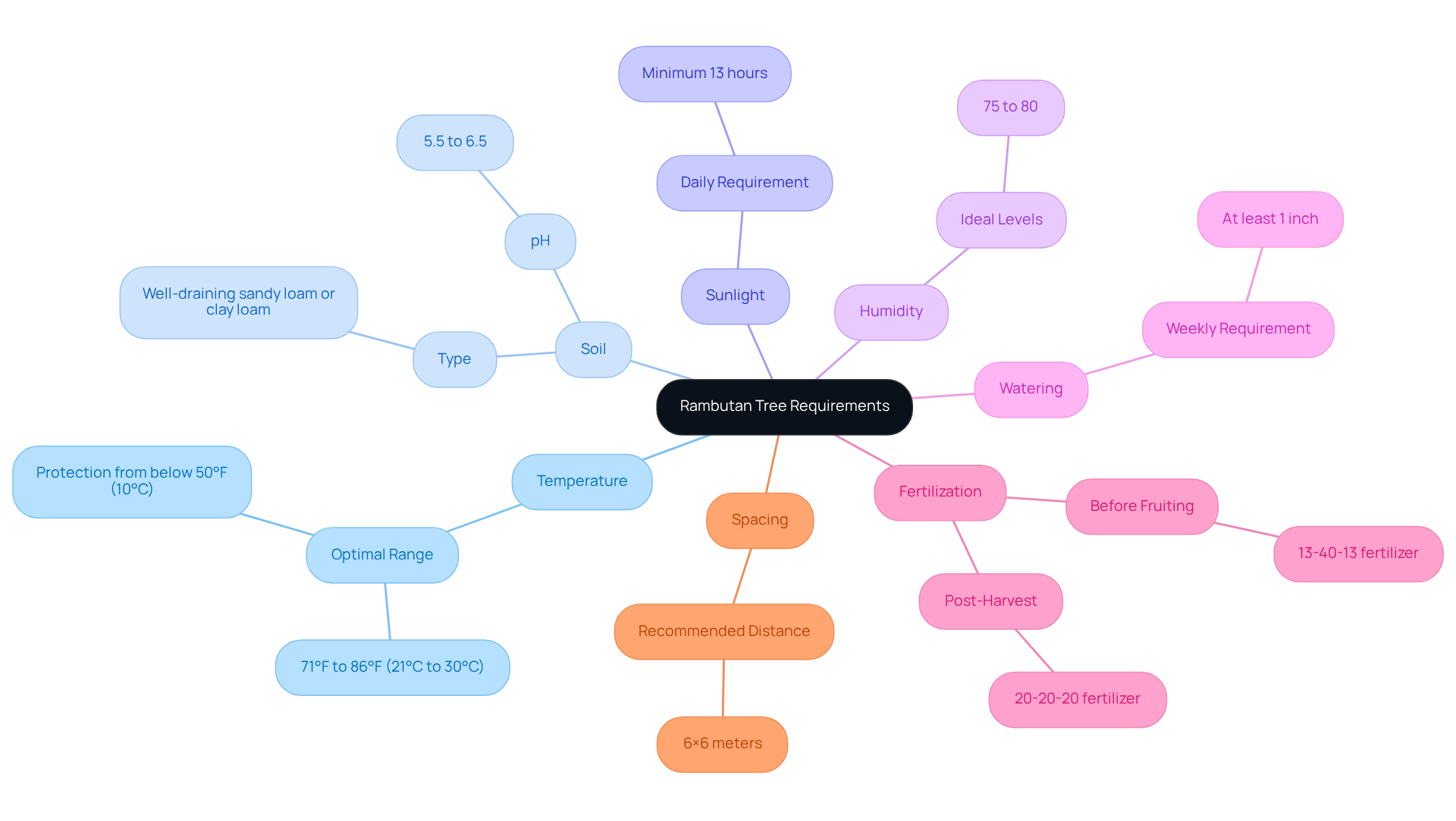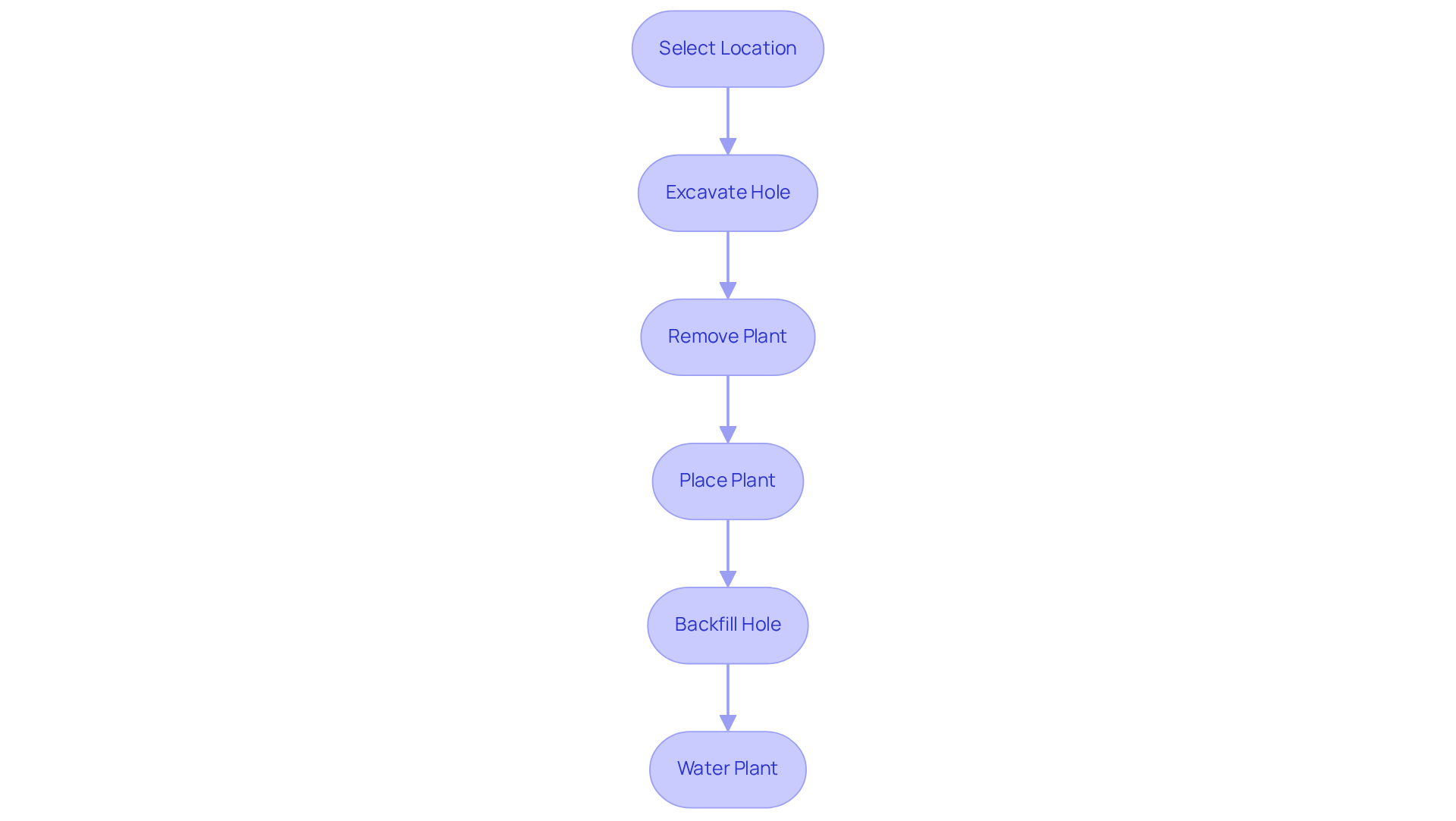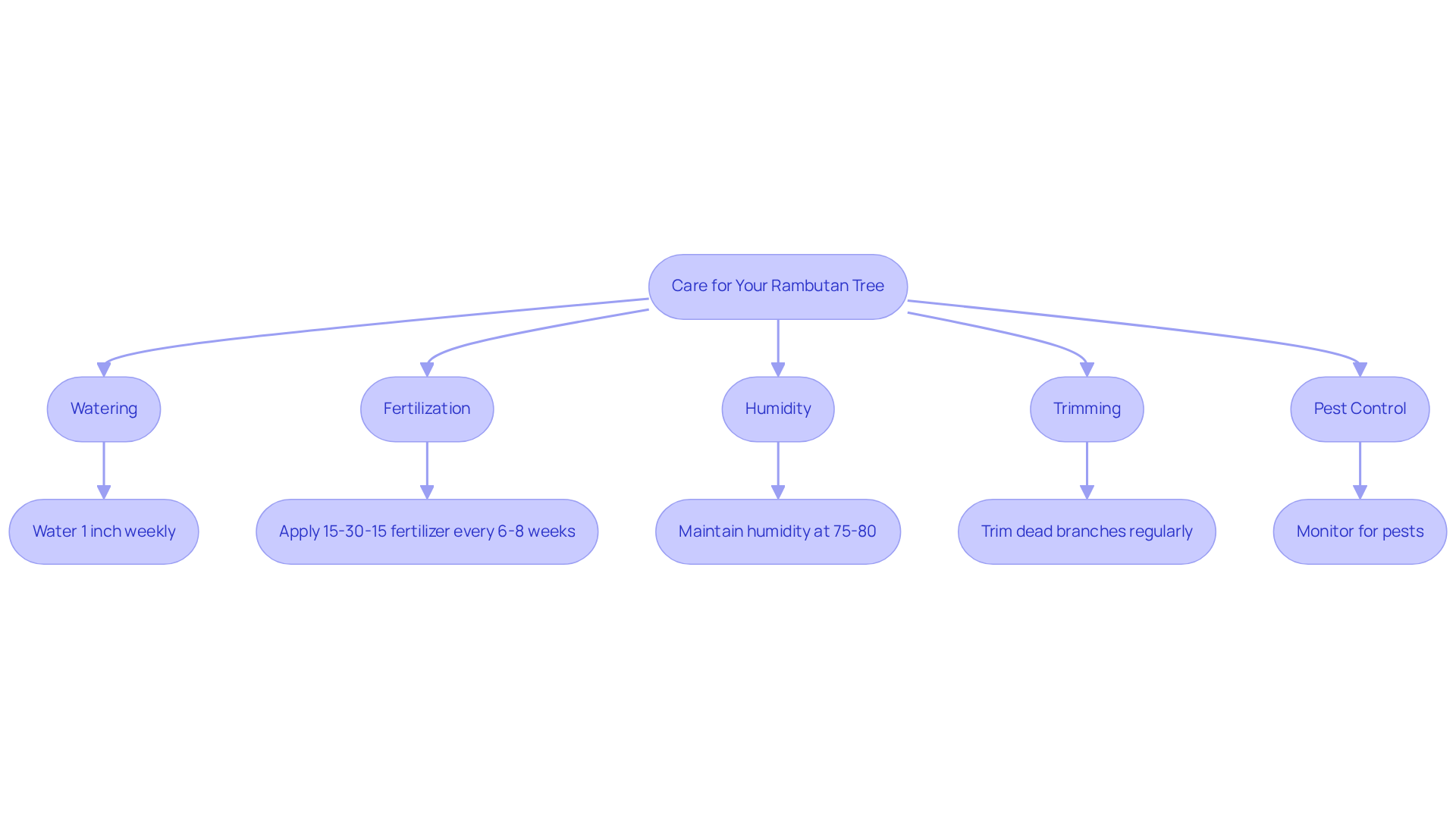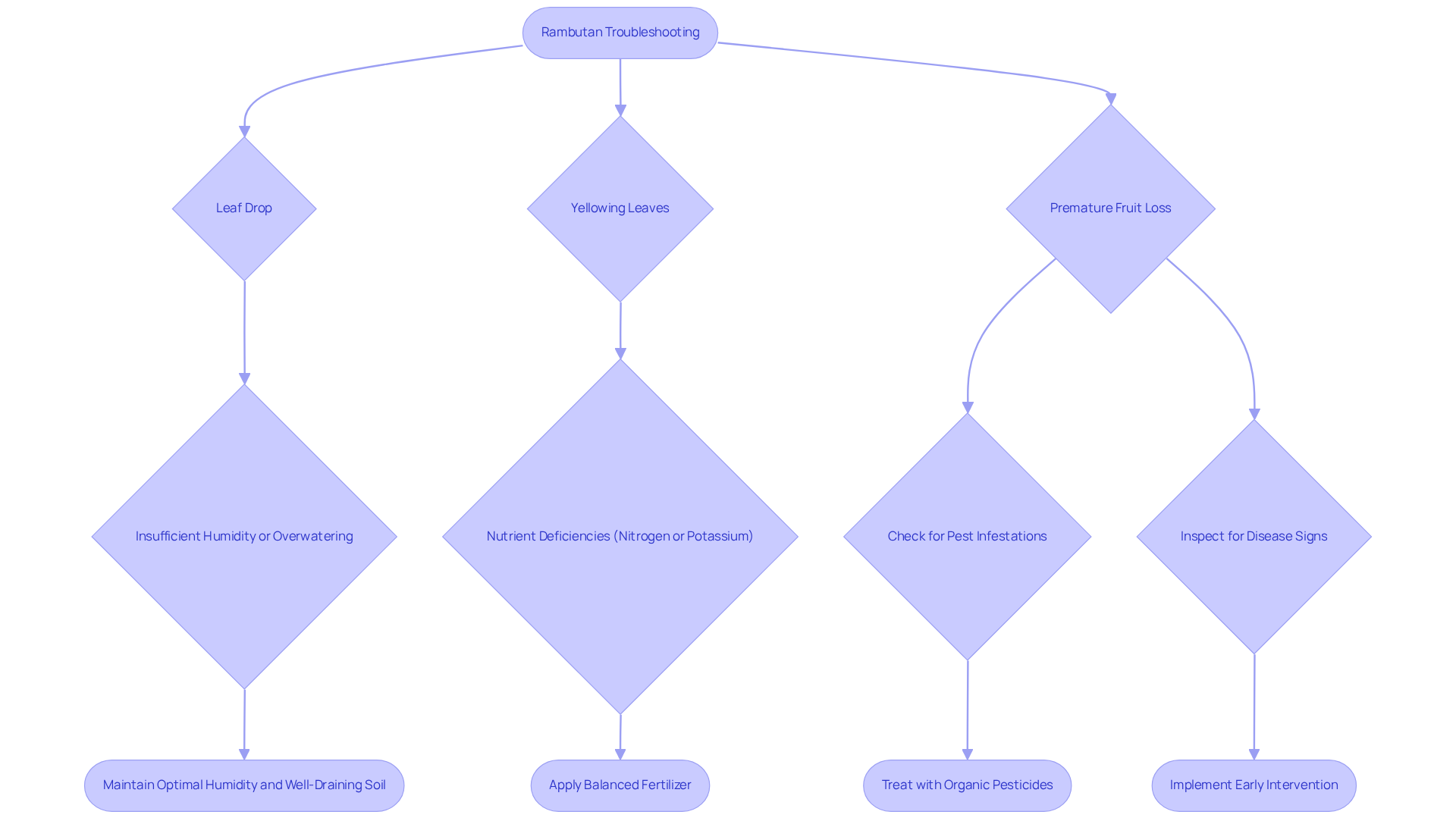To successfully grow a red rambutan tree, it is essential to plant it in a warm, humid environment with well-draining, slightly acidic soil. Consistent moisture and ample sunlight are also crucial for the tree's growth. This article emphasizes that adhering to specific care practices—such as:
- Proper planting techniques
- Regular fertilization
- Vigilant monitoring for pests and diseases
is vital for maintaining the tree's health and maximizing fruit production. By following these guidelines, gardeners can ensure a thriving red rambutan tree that yields abundant fruit.
Thinking about growing a Rambutan Tree?
👉 Shop Red Rambutan Tree grown with care at Everglades Farm and shipped from our Florida nursery.
1. Understand Rambutan Tree Requirements
Red rambutan trees thrive in warm, humid environments, ideally within a temperature range of 71°F to 86°F (21°C to 30°C). They require well-draining, slightly acidic soil with a pH between 5.5 and 6.5, which is vital for effective nutrient absorption. To support robust growth and fruit production, these plants need a minimum of 13 hours of sunlight daily. Selecting a planting location that allows for good air circulation and offers protection from strong winds is crucial, as these factors can adversely affect young plants. Additionally, maintaining humidity levels between 75-80% is essential to replicate their native tropical habitat, promoting optimal growth and vitality.
Rambutan plants necessitate at least 1 inch of water each week to thrive. Before fruiting, it is advisable to apply Everglades Farm's professional-grade 13-40-13 fertilizer, specifically designed to encourage vigorous development and fruiting. After harvest, transitioning to a 20-20-20 fertilizer will cater to their evolving nutritional requirements. Protecting the red rambutan tree from temperatures below 50°F (10°C) is critical to prevent damage. When planting, ensure a spacing of 6×6 meters to facilitate proper growth and air circulation.
Explore the benefits of Everglades Farm's Fast-Growing Trees Collection, which showcases quick-yield tropical plants that enhance your home gardening experience. This collection offers vibrant options with exceptional growth potential, making it an excellent choice for gardening enthusiasts.

2. Plant Your Rambutan Tree
To successfully plant your rambutan, begin by selecting a sunny location that receives at least 13 hours of sunlight daily and has well-draining soil with a slightly acidic pH between 5.5 and 6.5. These conditions are essential, as rambutan plants thrive in tropical environments.
- Excavate a hole that is twice as wide and the same depth as the root ball of the plant to provide ample space for root expansion.
- Gently remove the plant from its pot, loosening any tightly bound roots to encourage robust development.
- Place the plant in the hole so that the top of the root ball is level with the surrounding soil.
- Backfill the hole with soil, gently firming it around the roots to eliminate air pockets, which can hinder growth.
- After planting, water the plant thoroughly to help settle the soil and establish the roots.
It is also crucial to position fruit-bearing plants 30 to 40 feet apart to ensure sufficient air circulation. Additionally, consider using mulch around the base to preserve moisture and inhibit weeds, creating an ideal setting for your fruit-bearing plant to thrive.
These practices align with the user manual details for cultivating soursop and passion crops, emphasizing the significance of adequate sunlight, soil conditions, and root management to encourage healthy growth. Following these steps will lay the foundation for a healthy and productive red rambutan tree, enabling you to enjoy its unique fruit in the years ahead.
As gardening expert Katherine Rowe observes, 'Proper planting methods are crucial for the long-term success of your plants.

3. Care for Your Rambutan Tree
Rambutan plants thrive with consistent moisture, requiring at least 1 inch of water weekly. To ensure optimal growth, it is essential to adjust your watering schedule based on rainfall and soil moisture levels, preventing both over and under-watering. During the growing season, fertilization is key; applying a balanced fertilizer, such as a 15-30-15 formula, every 6-8 weeks supports robust foliage and fruit development. Additionally, maintaining humidity levels between 75% and 80% is crucial for optimal plant health.
Regular trimming is also important to remove dead or damaged branches, which promotes new growth. Kaleigh Brillon, an experienced gardener, advises that watering fruit trees with smaller amounts several times is more beneficial than a single deep soaking. Vigilance is necessary; monitor for pests and diseases, employing organic methods like neem oil for pest control when needed. By following these care practices, you can ensure that your rambutan plant remains healthy and productive.
Keep in mind that the red rambutan tree typically begins producing fruit in 4-5 years, making consistent and appropriate maintenance vital for future yields.

4. Troubleshoot Common Rambutan Growing Issues
The red rambutan tree can encounter several common issues, including leaf drop, yellowing leaves, and premature fruit loss. Leaf drop is often associated with insufficient humidity or overwatering; thus, maintaining optimal humidity levels and ensuring well-draining soil with a slightly acidic pH is essential for their health. Furthermore, red rambutan trees require approximately 6-8 hours of sunlight each day to thrive and produce effectively.
Yellowing leaves typically indicate nutrient deficiencies, particularly in nitrogen or potassium. To address these deficiencies, applying a balanced fertilizer, especially a slow-release type at the beginning of the growing season, can be beneficial. If premature fruit drop occurs, it’s important to check for pest infestations, such as fruit flies or borers, and to treat them promptly with organic pesticides.
Regular inspections for signs of disease, like powdery mildew, are crucial; early intervention can significantly help manage outbreaks. Consistent moisture levels are vital, as both overwatering and under-watering can impede nutrient uptake and negatively impact overall plant health.

Conclusion
Successfully growing a red rambutan tree demands careful attention to its specific needs, encompassing the right climate, soil conditions, and proper care. By understanding these requirements and implementing the recommended practices, gardeners can cultivate a healthy tree that yields delicious fruit for years to come.
This article outlines essential steps for nurturing a rambutan tree, including:
- Selecting an appropriate planting site
- Ensuring adequate watering and fertilization
- Maintaining optimal humidity levels
It emphasizes the importance of monitoring for common issues such as leaf drop and nutrient deficiencies, as well as employing organic methods for pest control. Each of these elements plays a critical role in fostering a thriving rambutan tree.
Ultimately, the journey of growing a red rambutan tree transcends the mere act of harvesting fruit; it is an enriching experience that deepens one’s connection with nature. By adhering to the outlined steps and remaining vigilant in their care, gardeners can relish the rewarding process of nurturing this tropical delight. Embrace the opportunity to cultivate a red rambutan tree and transform your gardening space into a vibrant oasis filled with unique flavors and beauty.
Cultivate Your Own Tropical Paradise Today!
Start growing rambutan and other tropical fruits with Everglades Farm's premium trees delivered to your doorstep.
🌳 Explore Exotic Trees
🌳 Explore Fruit Tree Collection
🌳 Buy Red Rambutan Tree
Frequently Asked Questions
What are the ideal temperature conditions for growing red rambutan trees?
Red rambutan trees thrive in warm, humid environments, ideally within a temperature range of 71°F to 86°F (21°C to 30°C).
What type of soil do rambutan trees require?
Rambutan trees require well-draining, slightly acidic soil with a pH between 5.5 and 6.5 for effective nutrient absorption.
How much sunlight do rambutan trees need for optimal growth?
Rambutan trees need a minimum of 13 hours of sunlight daily to support robust growth and fruit production.
What humidity levels are necessary for rambutan trees?
Maintaining humidity levels between 75-80% is essential to replicate their native tropical habitat and promote optimal growth.
How much water do rambutan trees need each week?
Rambutan trees necessitate at least 1 inch of water each week to thrive.
What type of fertilizer should be used before and after fruiting?
Before fruiting, it is advisable to apply Everglades Farm's professional-grade 13-40-13 fertilizer. After harvest, transitioning to a 20-20-20 fertilizer is recommended to cater to their evolving nutritional requirements.
What temperature should rambutan trees be protected from?
It is critical to protect red rambutan trees from temperatures below 50°F (10°C) to prevent damage.
What is the recommended spacing when planting rambutan trees?
When planting, ensure a spacing of 6×6 meters to facilitate proper growth and air circulation.
What is the Fast-Growing Trees Collection by Everglades Farm?
The Fast-Growing Trees Collection showcases quick-yield tropical plants that enhance home gardening experiences, offering vibrant options with exceptional growth potential for gardening enthusiasts.





0 comments